.jpg)
Land Rover Defender Review
.jpg)
Introduction
The word ‘icon’ is bandied around far too often, but every once in a while you come across something that is truly iconic. Take, for example, the Land Rover Defender. A stalwart of the Land Rover range and utterly unstoppable off-road, it became a firm favourite among farmers, tree surgeons and anyone else in need of a utilitarian 4x4.
Nowadays, the shepherds have moved into quad bikes and pick-up trucks, and the only customers who could afford the Defender were people who wanted a premium SUV but fancied something a bit more rugged. Some of those customers, though, might have found the Defender too rugged, what with its awkward driving position, cramped cabin and lumpy driving experience.
So the new model has a difficult task on its hands. The farmer market is lost to the likes of Isuzu and Toyota, and so too is the hardcore off-road market, so the Defender has to become more palatable for luxury SUV customers without losing any utilitarian credibility. And as much as we hate to spoil the verdict, there’s no denying Land Rover has done a great job of filling that brief.
Select's rating score* - 4.3 / 5
At a Glance
Just one look at the new Defender tells you it’s more modern than its predecessor. Gone are the sharp corners, replaced with smooth, rounded edges and a chunky, robust silhouette. It’s still a sizeable car, even if you get the smaller three-door ‘90’ version, rather than the longer, ‘full-fat’ 110.
That change of image is a metaphor for the whole car, which has become slightly softer and less uncompromising in its approach. Where the old Defender was backward and uncomfortable, the new car is much more enjoyable to live with – it’s certainly more of a car, where its predecessor was a sort of cross between a tractor and a van.
In short, the Defender has become civilised, providing a comfortable, pleasant driving experience that will feel alien to anyone who drove its forebear. But it’s still an incredibly competent off-road vehicle, giving you the ability to clamber through boulder fields, plough through snowdrifts and wade through streams as well as anything else on the market. Because we all do that every day, obviously…
Anyway, the new Defender certainly has more strings to its bow, and it gives customers far more choice. There’s a wide range of petrol and diesel engines, many of which come with plug-in hybrid technology. And you can even have a plug-in hybrid version, if you so wish. You also get a selection of trim levels to choose from, including

Key Features
The Defender shares very little with the old car, but it has carried over a few classic Land Rover touches that give it some of its predecessor’s charm. Take, for example, the chequerplate panels on the bonnet. They aren’t real chequerplate – they’re plastic – but they give the car the impression of robustness that made the original such a great workhorse.
Then there are the footwells that can be mopped out when they get muddy. It sounds like a sop to farmers who will never lease a Defender anyway, but they are really quite useful. If you jump in with muddy wellies, simply pull out the carpets and drive home in the knowledge you can wash the muck away with no trouble at all.
Performance & Drive
The Defender is available with a wide range of engines, and each has a noticeable impact on the driving experience. Things kick off with the 3.0-litre D200 diesel, which is only available with SE-spec 110s and offers 200hp. From there, you can have the D250 and D300 diesels, which are more widely available and respectively eke 249 and 300hp from the same 3.0-litre mild-hybrid engine.
Then there are the petrols, which start with the 2.0-litre, 300hp P300, then on to the 3.0-litre straight-six P400. At the top of the range is the P525, a 5.0-litre V8 with 525hp. Or you could opt for the P400e plug-in hybrid, which boasts 404hp from a 2.0-litre petrol engine and electric motor.

For most customers, diesel will offer the best balance of performance and economy, with the D250 and D300 proving the front runners. Both are lovely engines, but the 300 has a little more power and very similar running costs, making it the one to choose. Assuming you go for that engine, you’ll find the Defender punchy without being rapid. It has more than enough to keep up with traffic, but you’d never call it fast. Choose the V8, however, and that might change.
By and large, though, the Defender is distinctly un-sporty. It wallows through corners like an ocean liner, and it’s about as easy to steer. It seems to take a split second before inputs from the helm make any difference to the front wheels. That said, it’s still much better than its predecessor, offering more comfort and much more refinement. As long as you stick to main roads and sensible speeds, it’ll be a lovely thing to drive.
But it feels most at home off-road, where it has incredible capability. Armed with a range of clever systems to make the most of any available traction, it’ll cross rivers, scramble over rocks and carry on where plenty of luxury SUVs would have given up. It may not have the charm and simplicity that made early Defenders a hit in remote areas, but it’ll still cut the mustard when it’s muddy.
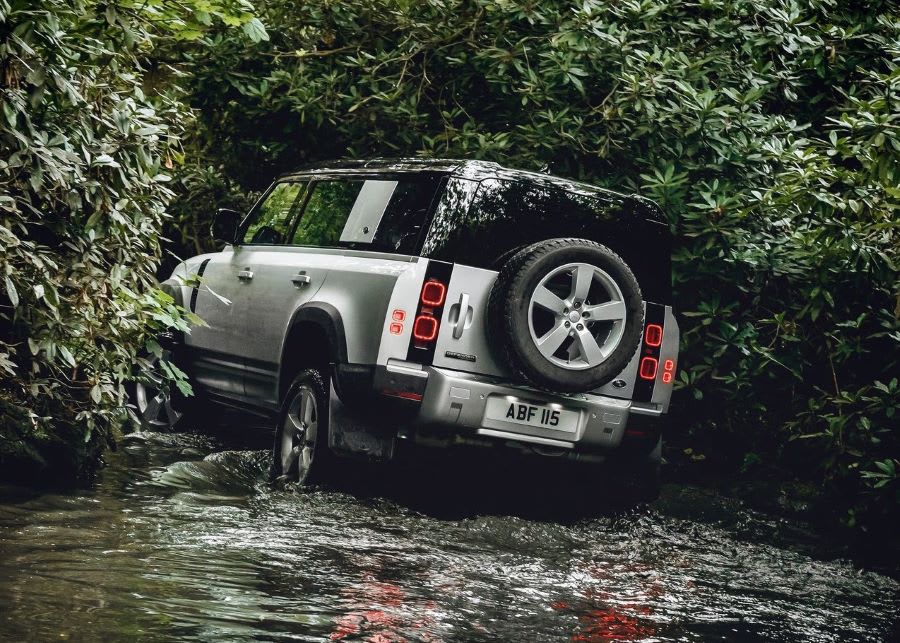
Running Costs & Emissions
Even with the hybrid engine technology and the option of diesel power, the Defender isn’t going to be cheap to run. The D300 diesel engine, which is arguably the pick of the range, won’t go above 35mpg or so, and even the smaller diesels won’t save you too much at the pumps. And if you go for the petrol engines you’d better get on well with the cashier at your local filling station. And every other filling station in the land.
The exception that proves that rule is the plug-in hybrid P400e, which might prove cheaper to run, as long as your lifestyle suits the hybrid system. If most of your journeys are made up of short runs to the shops, school or work, you might be able to use electrical power most of the time, thanks to the 27-mile zero-emission range. Assuming you can charge regularly, that could allow you to use very little petrol on a day-to-day basis. However, when you hit the road on a longer drive, the P400e is going to guzzle unleaded like it’s going out of fashion.
If you’re leasing the Defender as a company car, however, the P400e is more likely to be for you. It manages to emit just 75g of carbon dioxide per kilometre, which will keep your company car tax bill down. However, it’s worth noting that diesel might work out cheaper if you have to buy your own fuel and you cover a lot of miles. Make sure you do your sums before signing on the dotted line.

Interior & Technology
Although the Defender’s bodywork has changed dramatically, it’s the interior where the real changes have been made. The new cabin is far more luxurious than that of the old car, but it still lags some way behind Land Rover’s more upmarket models and their sumptuous rivals. That said, it has a similar vibe to the Jeep Wrangler, which is full of military- and off-road-inspired touches – some of which feel more naff than others.
In the Defender, the skeletal steering wheel and exposed screw heads feel a little unneccessary and a little incongruous alongside the snazzy touchscreen and digital instrument cluster. Nevertheless, the chunky switchgear, grab handles and wipe-down footwells are at least more useful, particularly if you are planning to use your Defender off-road.
But for all that, there’s no denying the Defender is now a luxury SUV. The seats are soft and highly adjustable, which means it’s easy to get comfortable, and although the driving position is still quite upright, it’s better than it once was.
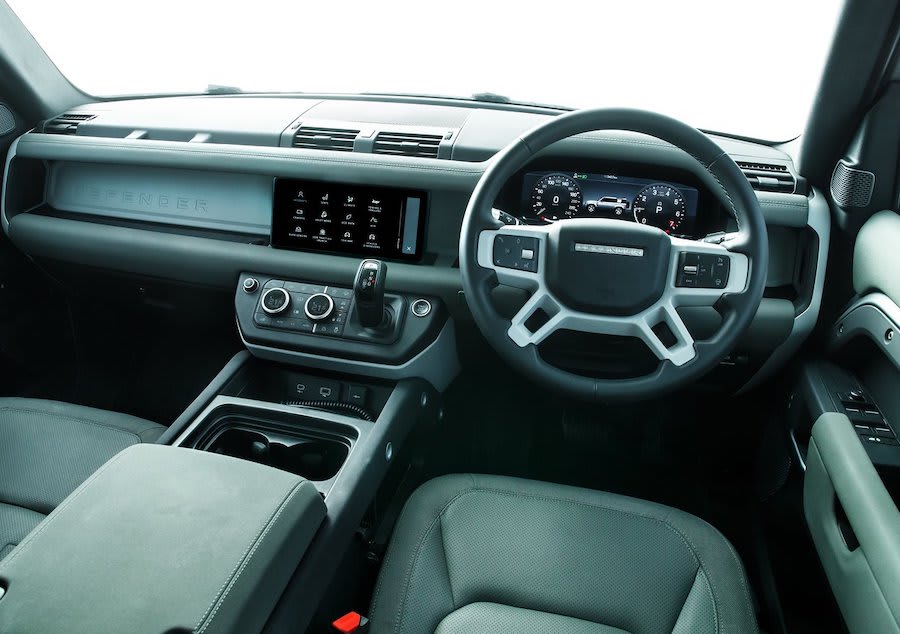
But the touchscreen infotainment system is a highlight – at least at first glance. It uses Jaguar Land Rover’s latest software, and it looks gorgeous. The design is minimalistic yet stylish, and the displays are very clear thanks to the high-resolution screen. The problem is the menus aren’t always very intuitive and the ‘buttons’ that appear on the screen aren’t the best. Nevertheless, it’s a big improvement on Land Rover systems of old, and it’s up there with the current Mercedes-Benz and Porsche systems.
Paired with that screen is the digital instrument cluster, which is also pretty good. It’s clear and it gives you all the information you need, so that’s a good start. It doesn’t have the functionality of the Audi Virtual Cockpit, but it doesn’t need to. Like the Defender of old, it just does the job with minimum fuss.
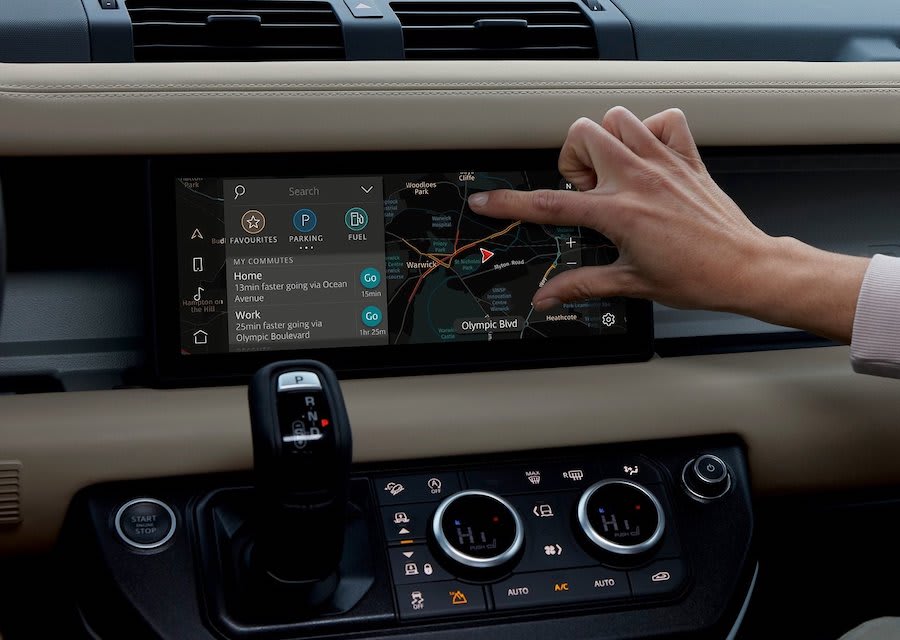
Practicality & Boot Space
As you’d expect, the Defender is a pretty practical car, but it does have one or two foibles. Chief among these is the side-hinged rear door, which makes it difficult to access the boot in car parks or any other tight spaces. It does mean you can mount the spare wheel on the door, though, and that frees up space in the back.
Not that there’s a shortage of room back there. The three-door 90 model has a 397-litre boot if you load up to the window line, while the 110 has 916 litres of space if you keep the back row of seats folded away. You also have the option of fitting panniers to the sides of the car to carry more, or you can ram stuff on the roof. Alternatively you could just fold down the back seats, freeing up a massive 2,233 litres of space if you go for the 110.
Passenger space is more of a mixed bag. The seven-seat 110 is easy enough to get into and there’s plenty of room in the back. However, the 90 doesn’t have back doors, and that makes accessing the rear more difficult. The 110 also has seats under the boot floor, and that means you can, if you’re desperate, carry seven. They aren’t big seats, though, and only children will want to spend any length of time back there. The same goes for the 90’s jump seat between the front chairs. It isn’t roomy, but it allows the car to carry six if needs be.
But there are advantages to the Defender’s rugged features. The carpet-free footwells can be mopped out, and there are plenty of storage bins in the off-road-inspired dash. If the Defender can swallow everything you need for a week in the wilderness, it can cope with whatever you need to take for a weekend with the in-laws.
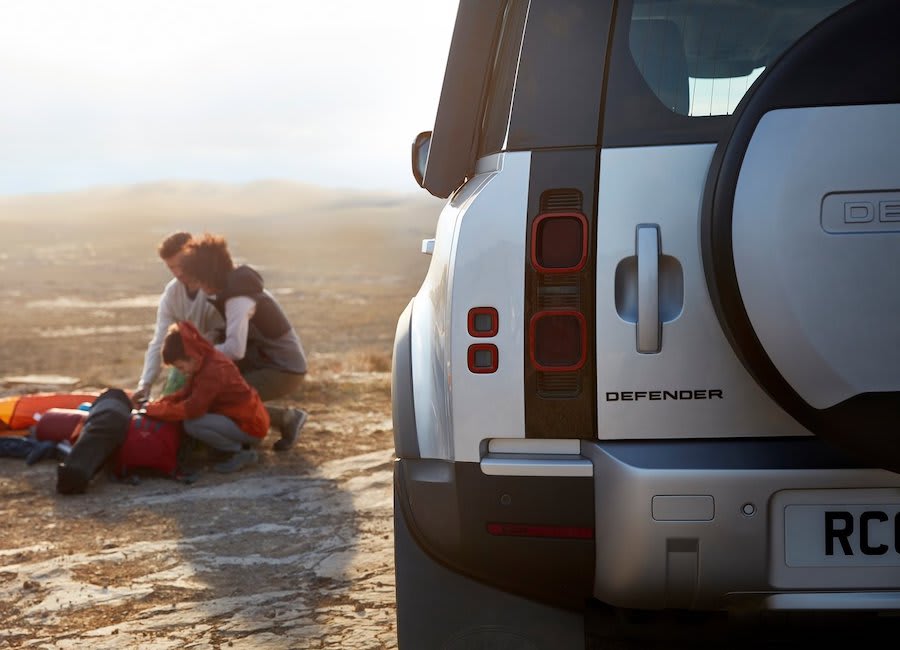
Safety
The Defender is, as you might expect, a pretty safe vehicle. In the Euro NCAP crash test process, the car scored a top-end five-star score, with solid results in every area. Admittedly, the Land Rover didn’t shine in any one particular area, but its ratings were strong across the board, with good adult and child occupant protection scores.
And unlike its forebear, the big Land Rover also comes with plenty of technology to keep you and everyone else as safe as possible. An emergency braking system will slam on the anchors automatically if you fail to respond to an oncoming hazard, while you also get cruise control, parking sensors and lane-keeping assistance with all passenger versions of the Defender. A 360-degree surround camera system is also included, along with Wade Sensing that shows you the depth of any water you’re driving through.
All that comes as standard, but extra safety technology is available, assuming you’re prepared to pay for it. Hit the options, and you can have tech that tells you when it’s safe to pull out of a parking bay or helps to prevent rear-end accidents.
Options
The list of options available to Defender customers would make War and Peace look like a kids’ book. But the first choice is a simple decision between the Hard Top commercial model – essentially a Defender van with no back seats – and the standard passenger-carrying Defender. Then you have to choose between the three-door 90 model and the longer five-door 110 version.
Assuming you opt for the passenger version, you’re then faced with a choice of different trim levels. Things kick off with the basic Defender S model, which comes with 19-inch alloy wheels, keyless entry and heated front seats with leather facings, as well as a digital instrument cluster and the 11.4-inch Pivi Pro touchscreen with Android Auto and Apple CarPlay smartphone integration tech.
Moving up to the SE gets you larger 20-inch alloys and an electrically adjustable steering column, plus 12-way electrically adjustable front seats and a Meridian sound system. The HSE, meanwhile, provides extra leather upholstery, a heated steering wheel and 14-way electrically adjustable seats with heating and ventilation.
Those three trim levels are also available in conjunction with the X-Dynamic specification, which adds some glossy black exterior trim and black alloys, as well as some smaller tweaks such as the exposed rear towing eyes.

Then you move on to the XS Edition, with its body-coloured lower cladding, panoramic sunroof and 20-inch alloy wheels. That car also gets the Meridian sound system, plus wireless phone charging and the ClearSight rear-view mirror, which uses camera technology to ensure you can see what’s behind no matter how full the boot may be or how many people you have in the back.
After that, it’s all down to the more specialist models, with the Defender X marking the next rung of the ladder. With a sporty off-road vibe, that car gets orange brake callipers and darkened tail lights, as well as part-leather upholstery and a head-up display.
Finally, there are the V8 models. As standard, the V8 Defender gets dark exterior trim, 22-inch alloys and four exhaust pipes. Inside, you’ll find suedecloth upholstery, a suede-wrapped steering wheel and wireless charging technology with a phone signal booster. And if you upgrade to the V8 Carpathian Edition, you’ll get Carpathian Grey paint with a black contrast roof, a black bonnet and a black front end. You’ll also find yourself with some natty gloss black alloy wheels.
The Defender options list is enormous, and there simply isn’t space to go through it here, but we can pick out a few favourites. The Air Suspension pack is one such option, giving you enormous control over the car’s ride height. You can lower it to access mode when you get in and out, or raise it to its full height, giving the car more ground clearance for serious off-roading. Most of the time, you’ll want it in its normal setting, but if you’re in a traffic jam with nothing else to do, it’s quite good fun to pump the suspension up and let it down. It’s like being in one of those American lowriders, albeit slightly more British and middle-class.
Those who do a lot of off-road driving may also like the Off-Road Pack, which gives you proper mud-plugging tyres and a clever electronic differential to improve traction. Or there’s the Pet Care and Access Pack for dog owners, giving you a pet access ramp, a loadspace liner and a partition to separate the boot from the cabin. There’s even a portable dog shower for cleaning your pooch.
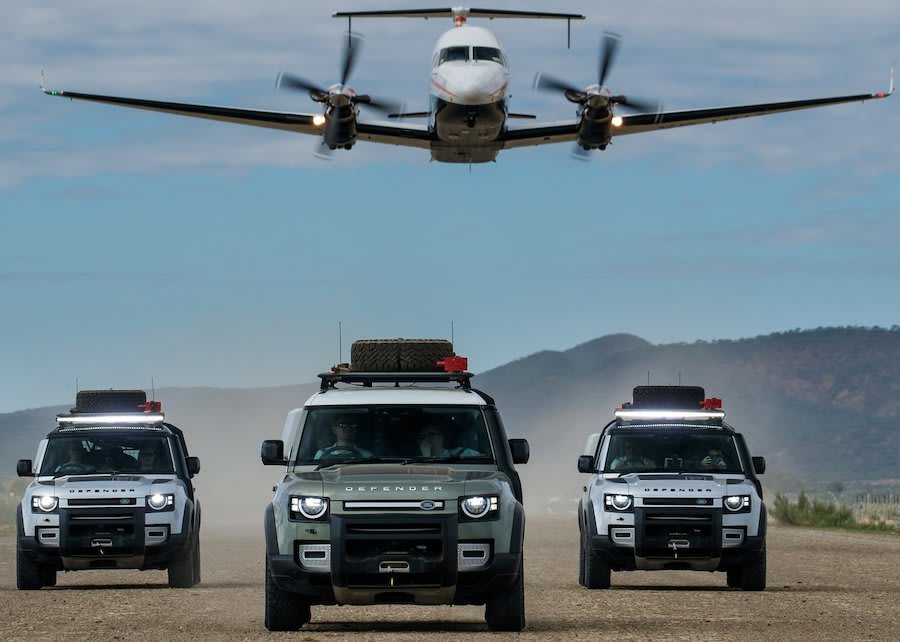
Rival Cars
The Defender’s new attitude has opened up a much broader range of rivals to pick a fight with. The Jeep Wrangler arguably remains the Defender’s closest competitor, but although its road manners are much improved, it’s still very much an off-road vehicle. And if that’s what you’re after, it’s probably a better choice.
However, the Defender is trying to compete with luxury cars these days, and that means it’s up against the Mercedes-Benz G-Class, the definition of off-road luxury and excess. The Defender is much cheaper, but it’s less luxurious.
Other rivals include the Toyota Land Cruiser, which has become a firm favourite among off-road enthusiasts and still offers quality, luxury and reliability. Or you could look at the Volkswagen Touareg or Volvo XC90 – both of which are luxury SUVs with off-road capability – or any of the German SUVs: the BMW X5, Mercedes-Benz GLE, Audi Q7 and even the Porsche Cayenne will all be possible alternatives for some Defender customers.
And there are rivals in Land Rover’s own ranks, with the Discovery offering similar levels of space and capability with slightly more luxury – all for similar money. You could also count the smaller Discovery Sport and more road-focussed Range Rover Velar among the Defender’s competitors.
Verdict & Next Steps
Love it or hate it, there’s no doubt the new Defender does the job Land Rover asked of it. It’s much better on the road and unstoppable off it. It has far more creature comforts than its predecessor, but some neat touches have been carried over to give it at least some of the old car’s credibility. The only catch is, the Discovery and Range Rover models are just as capable, more luxurious and similarly priced. But those cars don’t come with the Defender’s character, image or history. They aren’t iconic, and that makes all the difference.
Where to next?
View latest Land Rover Defender leasing deals- guide price from £645.19 per month inc VAT**
Looking for a great deal? Check out our incredible range of car lease deals
New SUV? Read our latest Reviews and find the right model for you
Want to know more about leasing? Take a look at our comprehensive Leasing Guides
Interested in everything motoring? Why not catch up on all the latest Car Leasing News.
*Score based on Select’s unique meta score analysis, taking into account the UK’s top five leading independent car website reviews of the Land Rover Defender
**Correct as of 22/10/2021. Based on 9 months initial payment, 5,000 miles over a 48 month lease. Initial payment equivalent to 9 monthly payments or £5806.71 Ts and Cs apply. Credit is subject to status.





















